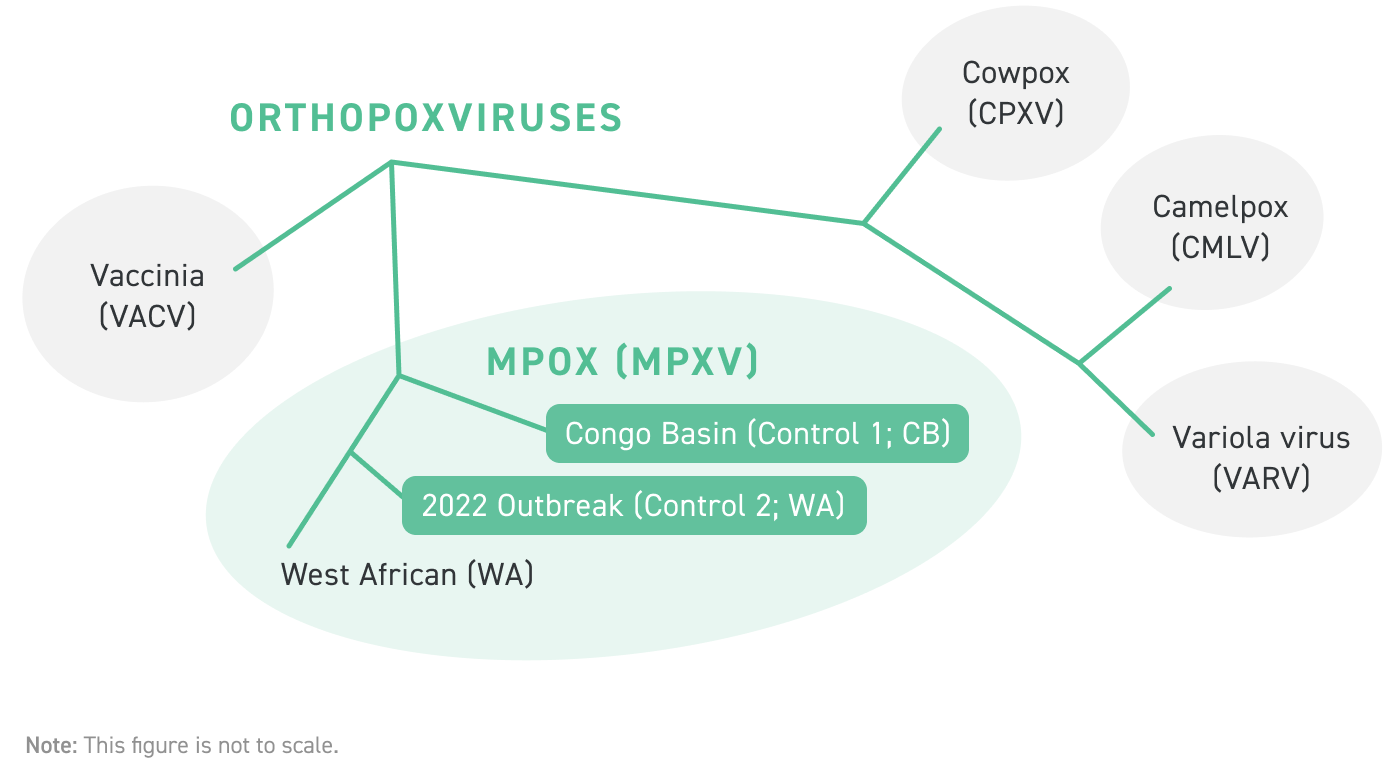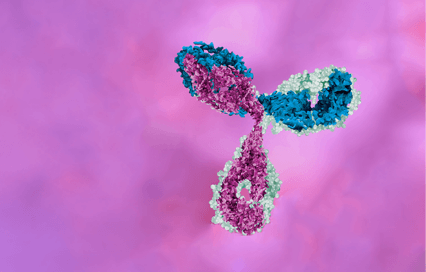
On September 22, 2017, an 11-year-old boy was admitted to the Niger Delta University Teaching Hospital in Nigeria. For more than a week, the boy had been lethargic and feverish with large lesions dotting his body. Though it hadn’t been reported in Nigeria for nearly 40 years, the boy appeared to be infected with the mpox (a virus formerly known as monkeypox)1.
At the time, researchers knew of two dominant mpox viral clades in Africa: a west African clade known to be relatively mild, and the more severe central African (Congo Basin) clade. Previous outbreaks in Nigeria were small flare-ups brought on by west African strains. Patients were often children and there was little to no human-to-human transmission2,3. This burgeoning outbreak, however, was different.
By December of 2017, approximately 200 suspected or confirmed cases had been reported, with many of the patients being young adult men2. The rapidly growing case count paired with the abnormal patient demographics suggested that this strain of the mpox virus was more transmissible than what Nigeria had seen in the past3.
Through the use of next-generation sequencing, researchers from the Nigerian Centers for Disease Control, the U.S. Army Medical Research Institute of Infectious Diseases, and the Institut Pasteur in Dakar, Senegal were able to interrogate the virus’ genome and compile a phylogenetic map4. The data indicated this new strain had evolved from the west African clade and was likely the result of zoonotic spillover (animal to human transmission). Unlike previous strains, this virus had gained the ability to spread through bodily fluids, making it far more capable of spreading among humans.

News of the outbreak eventually faded as case counts dropped. Now, less than four years later, a mpox virus strain descended from the 2017-2018 outbreak is making headlines around the world, turning the mpox virus–like SARS-CoV-2 before it—into an infamous household name5.
As many learned during the COVID-19 pandemic, combating infectious diseases like mpox requires a myriad of molecular tools, many of which rely on synthetic DNA and RNA. The versatility of synthetic nucleotides allows them to be used in a broad spectrum of applications, from pathogen identification and characterization to therapeutic development. Twist Bioscience is a leader in this space, leveraging our industry-leading DNA synthesis platform to help researchers quickly build the tools they need to address infectious disease outbreaks.
Synthetic Nucleotides in Countering Infectious Disease
Quantitative real-time PCR (qPCR) has emerged as a powerful diagnostic tool, particularly when dealing with infectious diseases. Generally, these tests work by first collecting a tissue sample from the patient, specifically tissue where the virus is likely to be found (for SARS-CoV-2, mucus is sufficient; for the mpox virus, lesion tissue, dry skin, or blood is needed). DNA probes can then be used to target and amplify specific viral genes. As the genes are copied, a signal indicating their presence is also amplified, enabling minuscule amounts of viral DNA or RNA to be sensitively detected.
As with any experiment, qPCR assays require positive controls to prove that the test is capable of detecting genetic material from viruses when present. Traditionally, positive controls could be sourced from patient samples that are known to contain the target virus. However, working with a live virus is not only dangerous but is also quickly made obsolete. SARS-CoV-2 continues to remind us that viruses evolve rapidly and the mutations they accrue can cause PCR probes to no longer amplify the viruses’ RNA.
Synthetic nucleotides are a safer, more robust option. Twist Bioscience has the ability to precisely synthesize viral genes that can be used as positive controls during test development. These controls can be easily iterated, customized, and rapidly synthesized, enabling researchers to quickly update their tests as new viral variants arise.
🦠 What is mpox virus?
Mpox virus is a type of orthopox virus that was first discovered in captive monkeys in the 1950s. In spite of its original name, mpox (formerly referred to as monkeypox) is known to predominate in rodents and has been responsible for multiple small-scale epidemics in humans over the past 50 years. As with other orthopox viruses, such as smallpox, mpox infections often lead to fevers, sluggishness, and painful rashes. Unlike smallpox, however, this virus is not often lethal. Historically, spread of mpox viruses among humans was minimal. However, the strain that has led to outbreaks on multiple continents in 2022 appears to be more transmissible through skin-to-skin contact and the sharing of bodily fluids.
Accuracy is a critical feature of synthetic controls. Small errors in DNA or RNA sequences can reduce the affinity between PCR probes and the synthetic control strand, resulting in a diminished signal. When this happens, test results may be rendered invalid. It is critical, then, that positive controls be precisely engineered.
Twist has leveraged its industry-leading DNA synthesis platform to produce synthetic RNA controls for most of the major SARS-CoV-2 viral strains. Similarly, Twist has recently announced synthetic DNA controls for the mpox virus. Rather than targeting an individual strain, Twist has produced controls that recognize viral strains from both the West African and Congo Basin clades.
Importantly, the dominant strain of mpox virus making its way around the world appears to have mutated much faster than expected, leaving open the possibility that the virus will continue to evolve at a rapid pace. Tests will need to keep up with this evolution by producing probes and controls that reflect new mutations as they arise, or by integrating new target genes for amplification. Twist’s mpox viral controls cover over 80% of the full mpox viral genome and are sequence-verified using both NGS and ddPCR. This means that, as tests evolve to include additional target genes over time, Twist mpox viral controls remain as valuable control samples.
Beyond Controls
In addition to synthetic controls, Twist also produces fixed and custom content target enrichment panels. Probes in these panels target and hybridize to viral DNA, enabling the isolation and sequencing of viral genomes from challenging tissue samples (such as blood and lesion tissue). Using this target enrichment approach, researchers can focus their sequencing resources on just the viral genes they’re interested in, enabling much more efficient sequencing. Additionally, enrichment panels can be designed to target specific genes from a large breadth of potential pathogens.
With this breadth, researchers can simultaneously test for multiple viruses (or viral strains) when they’re unsure which pathogen is affecting patients. Such a panel was used to shed light on the origin of the mpox viral strain that was responsible for the 2017-2018 outbreak4.
✋ Biosecurity and Infectious Disease
Synthesizing genes from infectious agents requires careful oversight. Customers purchasing synthetic controls are subject to Twist’s industry-leading biosecurity and customer screening protocols as well as applicable laws and regulations. As DNA sequences from the mpox virus are controlled for export outside of the United States, Twist is required to apply for and receive an export license prior to shipment for international customers. Learn more about how Twist Bioscience is staying at the forefront of biosecurity in synthetic biology.
Currently, Twist offers both a comprehensive viral panel as well as a more focused respiratory virus panel that targets reference sequences for 29 common human respiratory viruses. However, custom content can also be added to these panels to ensure coverage over specific viruses or variants (Twist provides design support to build custom panels from scratch).
We’re hopeful that vaccines and improved public health measures will help to quell the SARS-CoV-2 pandemic and mpox virus outbreak. However, we also know that viral outbreaks are inevitable. Researchers will always need cutting-edge tools to help identify and mitigate these outbreaks when they happen, and Twist is committed to empowering their efforts with high-quality synthetic DNA and RNA.
**Updated on August 19, 2024 to reflect the virus' new naming convention, as suggested by the WHO
References
- Ogoina, Dimie, et al. “The 2017 Human Monkeypox Outbreak in Nigeria—Report of Outbreak Experience and Response in the Niger Delta University Teaching Hospital, Bayelsa State, Nigeria.” PLOS ONE, vol. 14, no. 4, 17 Apr. 2019, p. e0214229, 10.1371/journal.pone.0214229.
- Yinka-Ogunleye, Adesola, et al. “Outbreak of Human Monkeypox in Nigeria in 2017–18: A Clinical and Epidemiological Report.” The Lancet Infectious Diseases, vol. 19, no. 8, 1 Aug. 2019, pp. 872–879, 10.1016/S1473-3099(19)30294-4.
- “He Discovered the Origin of the Monkeypox Outbreak — and Tried to Warn the World.” NPR.org, www.npr.org/sections/goatsandsoda/2022/07/28/1114183886/a-doctor-in-nigeria-tried-to-warn-the-world-that-monkeypox-had-become-a-global-t.
- Faye, Ousmane, et al. “Genomic Characterisation of Human Monkeypox Virus in Nigeria.” The Lancet Infectious Diseases, vol. 18, no. 3, 1 Mar. 2018, p. 246, 10.1016/S1473-3099(18)30043-4.
- Isidro, Joana, et al. “Phylogenomic Characterization and Signs of Microevolution in the 2022 Multi-Country Outbreak of Monkeypox Virus.” Nature Medicine, 24 June 2022, 10.1038/s41591-022-01907-y.
What did you think?
Like
1
Dislike
0
Love
0
Surprised
0
Interesting
0







